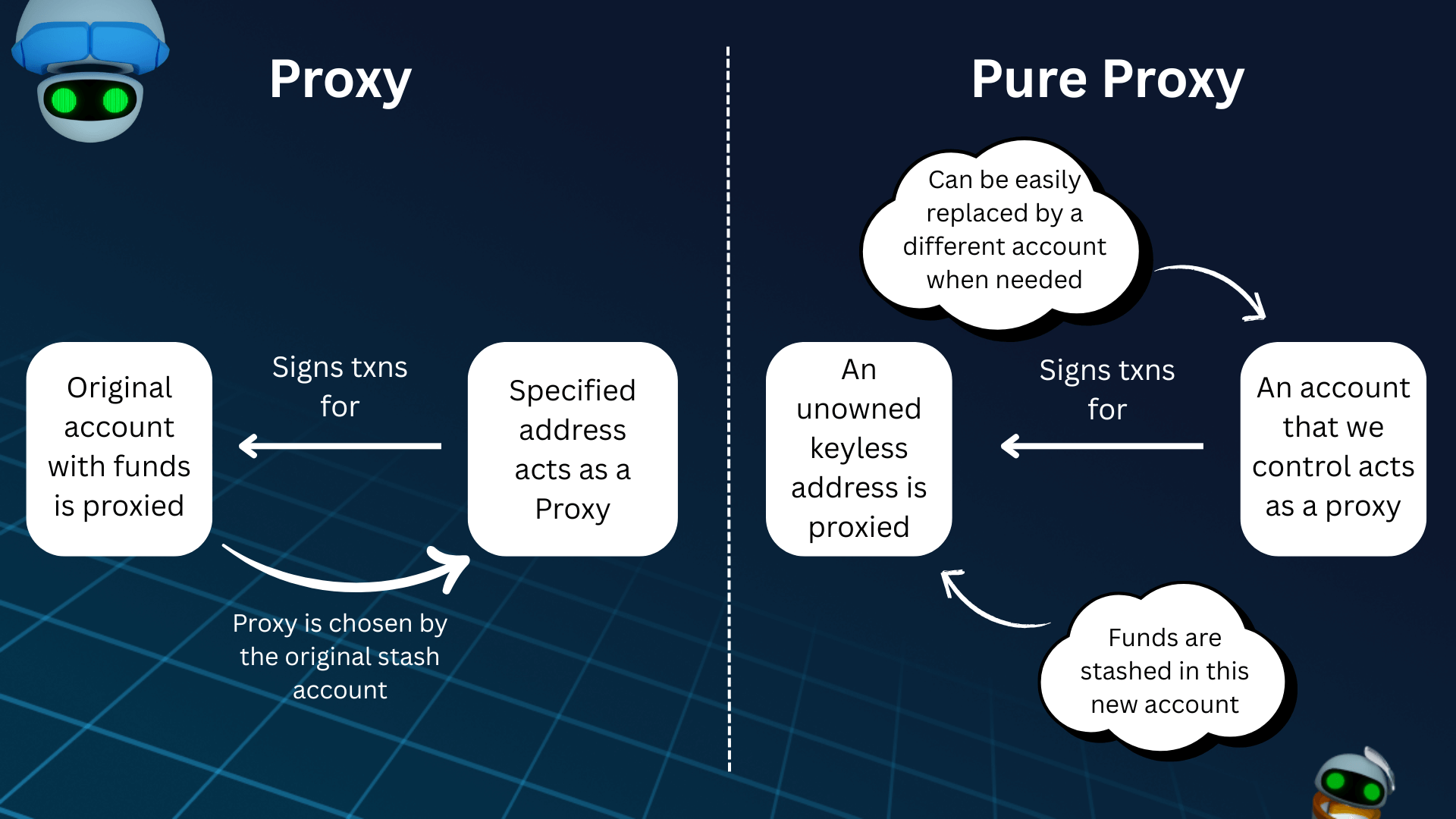Proxy accounts on Avail
Introduction
A ‘proxy’ of an account on Avail DA is simply another account on the network that has the power to sign transactions on behalf of the original account, also known as the ‘proxied’ account.
We can also configure the proxy to only have permission to sign a subset of all possible transactions on behalf of the proxied account. We will learn more about this later.
MAKE SURE YOU’RE COMFORTABLE WITH THE LINGO
- ‘Proxy’ - A proxy is an account that has the power to sign transactions on behalf of the proxied account.
- ‘Proxied’ - Refers to the original account that the proxies are signing for.
- ‘Any proxy’ - An account that has the power to sign any type of transaction on behalf of the proxied account. You can have many different types of proxies on Avail network. Refer to this section in our docs for more information.
‘Proxy’ vs ‘Pure proxy’
You can create two types of proxies on Avail DA:

Proxy accounts
When creating a proxy for an account you own, you choose the exact address of the proxy, which may or may not
be an address that you control.
You can do this using the proxy.addProxy extrinsic. The Avail Apps explorer provides a convenient UI abstraction for this,
instructions for which can be found here:
👉 The key principle to note here that is that you can create a proxy account that is not under your control.
For Example
You might have an account with a significant amount of funds that you want to stake on the network without taking on the responsibility of managing the staking operation itself.
You may, in this scenario, choose to add a friend’s account as a proxy to your original account, but with the stipulation that this proxy can only sign staking-related operations on your behalf.
You therefore have a situation where a second person has the power to stake funds on your behalf, but without the ability to outright transfer your tokens away.
- The example above was a hypothetical scenario. Please take care while delegating responsibilities to proxies that you do not control.
- You can always revoke a specific proxy’s permissions using the
proxy.removeProxyextrinsic.
Pure proxy accounts
When creating a pure proxy for an account you own, you do not get to choose the address of the proxy.
Therein lies the key difference between a proxy and a pure proxy.
While you get a deterministic address in the first case, the proxy address is randomly assigned in the second.
You can create a pure proxy using the proxy.createPure extrinsic.
The instructions for this can be found here:
Why would you want a pure proxy?
You will see this more clearly in the dedicated guide for setting up pure proxies, but the short answer is that using a pure proxy setup allows you to conveniently rotate the any proxy behind the pure proxy without having to move funds out of the pure proxy.
This is especially useful when the pure proxy is being used to hold funds on behalf of a committee that needs to vote on proposals using a multisig, which acts as the any proxy for the pure proxy.
For example:
-
Consider that a pure proxy account is being used to stake
AVAILon the network on behalf of a committee of 3 people. The committee votes on proposals using a multisig, which acts as the any proxy for the pure proxy. -
If one of the committee members needs to be replaced, a fresh multisig will need to be setup to accommodate the new member.
-
With a pure proxy setup, the old multisig can simply be rotated out in favour of the new multisig without having to unstake or move funds out of the pure proxy.
-
Any other way of implementing this would require an unstaking of funds followed by a migration into a new account.
Since nobody actually owns the private key of a pure proxy, it cannot be compromised via a private key leak.